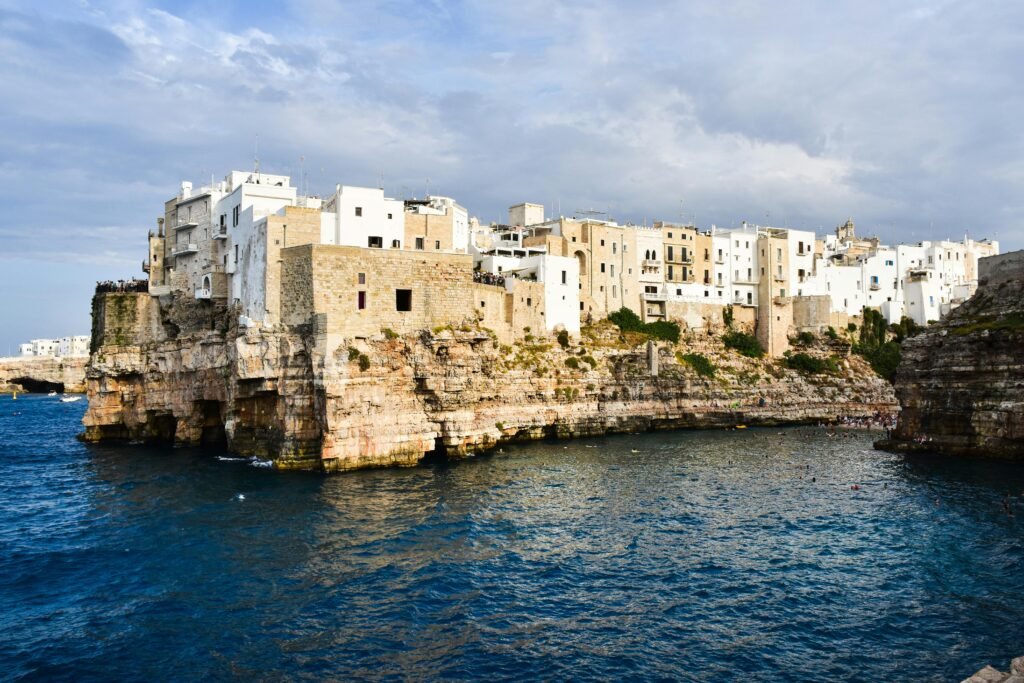I don’t know if words can truly capture it, but maybe the images will help: dry-stone walls, centuries-old olive trees, and a sea that hugs the horizon. For me, Puglia isn’t just another region in Italy — it’s a sensory journey, a return to simplicity, a sincere encounter with beauty.
The first time I visited, I had just turned 18. I had my license for less than a week when I decided to drive down to the heel of the Italian boot, without much of a plan — just the urge to explore. I still remember the blinding afternoon sun, the soft golden reflections of Lecce’s limestone, and the intense summer heat that forces you to slow down and absorb every detail.I remember the food — fresh orecchiette, the local rosé wine, old men chatting on street corners late into the evening. It was everything I had hoped Italy would be. Since then, I’ve returned at least once a year.
But visiting Puglia isn’t just a personal tradition. It’s something I now recommend regularly to guests planning their holidays in Southern Italy. When people ask me,
“How do we combine Sorrento and the Amalfi Coast with Puglia?”,
I always say the same: 5 days on the Coast, 5 days in Puglia — at minimum.
And if you’re wondering how to travel to Puglia, Italy, don’t worry. Whether you’re arriving from Rome, Florence, Amalfi Coast it’s easier than you think. There are multiple ways to fly to Puglia, with airports in Bari and Brindisi, and from Sorrento, Naples and Rome our private drivers will take you there in comfort.
Where is Puglia, Italy? And why you should go
If you’re still asking “Where is Puglia, Italy located?”, it’s in the southeastern part of the country, forming the heel of the Italian peninsula. It belongs to the region of Southern Italy, bordered by the Adriatic Sea to the east and the Ionian Sea to the south.
So, why visit Puglia, Italy? Because it offers something rare: beauty that’s raw, honest, and still largely undiscovered. Whether you’re exploring ancient towns, relaxing by the sea, or indulging in local food and wine, Puglia is worth visiting for its authenticity, charm, and affordability.
Puglia is a region, and one of Italy’s most culturally rich and geographically diverse.
Monopoli: Where to Stay in Puglia, Italy
If you’re wondering “Where to stay in Puglia?”, let me make it easy for you: Monopoli and its surroundings.
Despite the tourism boom, Monopoli has preserved its soul. You’ll find whitewashed alleyways, boats bobbing in the harbor, friendly faces, and an undeniable sense of peace. The town is ideally located on the Adriatic coast, just south of Bari, and it’s the perfect base for exploring the Itria Valley, Matera, Lecce, Salento and the coastline.
Whether you’re a couple, a family, or a larger group, I can suggest the perfect stay for you — from charming boutique hotels in the heart of town to authentic villas set among trulli or rustic masserie, just a short drive from Monopoli.
Surrounded by olive trees and peaceful countryside, these homes offer comfort, beauty, and privacy.
Either way, you’re bound to fall in love.

What to See in Puglia, Italy: Valle d’Itria and Beyond
From Monopoli, you can easily visit the highlights of the Itria Valley — a postcard-perfect landscape of rolling hills, whitewashed villages, and dry-stone walls.
- Alberobello, famous for its UNESCO-listed trulli, feels like a fairytale.
- Locorotondo, perched on a hilltop, is calm and geometrically perfect, with flower-lined balconies.
- Cisternino is rustic and festive, with smoky aromas of grilled bombette wafting through the air.
- Ostuni, the “White City,” sparkles under the southern sun and offers sea views from every corner.
- A little farther south, Lecce is a baroque gem, vibrant and theatrical.
- Don’t miss Matera, just beyond Puglia’s border in Basilicata — a city carved in stone, where ancient cave dwellings (Sassi) create one of the most unique and powerful urban landscapes in the world. It’s a UNESCO site and an unforgettable day trip from Monopoli.
- And of course, Polignano a Mare — perched dramatically on the cliffs over the Adriatic — is not just beautiful, it’s pure poetry. From its hidden beaches and sea caves to the verses painted on its doors and balconies, Polignano is one of those places that stays with you long after you’ve left.
- If you’re looking for immersive activities, we can arrange Vespa tours through the countryside, cooking classes with local chefs, or private boat tours along the coast — ideal ways to experience the region like a local.

These towns are the best answer to the question: “What is Puglia best known for?”
Architecture, food, slow life, and a timeless atmosphere that hasn’t been spoiled by mass tourism.
Is Puglia, Italy Safe? Is it Expensive?
One of the most common questions I get is whether Puglia is expensive or safe to travel. The answer to both is reassuring: Yes, it’s safe, and no, it’s not expensive, especially when compared to more famous regions like Tuscany or the Amalfi Coast.
Even the cost of living in Puglia is significantly lower than in northern cities. You’ll find high-quality meals, stylish accommodations, and incredible experiences at a fraction of the price.
So, how many days should you stay in Puglia?
At least 5 full days, but ideally 7–10 if you want to blend coast, countryside, and culture
Want to explore more?
Discover my personally curated 5-day itinerary to Puglia, filled with real experiences, local contacts, and private tours we organize every year through My Exclusive Italy.
➤ Read the full itinerary here
What I suggest:
Puglia has some of the most beautiful coastlines in Italy. If you’re heading to the beach, go early in the morning or later in the afternoon (locals love a sunset swim). Try beaches in Torre dell’Orso, Pescoluse (the “Maldives of Salento”), and Punta Prosciutto for crystal-clear water.